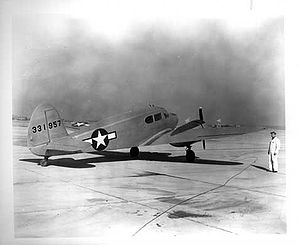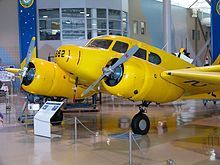- Cessna AT-17 Bobcat
-
AT-17 / UC-78 Bobcat
Model T-50Cessna AT-17 Bobcat Role five-seat light transport Manufacturer Cessna Aircraft Company First flight 1939 Primary users United States Army Air Forces
Royal Canadian Air Force
United States NavyNumber built 5,400+ The Cessna AT-17 Bobcat was a twin-engined advanced trainer aircraft designed and made in the United States, and used during World War II to bridge the gap between single-engine trainers and twin-engine combat aircraft. The AT-17 was powered by two Jacobs R-755-9 radial piston engines. The commercial version was the Model T-50, from which the AT-17 was developed.
Contents
Design and development
The AT-17 was a military version of the commercial Cessna T-50 light transport. The Cessna Airplane Company first produced the wood and tubular steel, fabric-covered T-50 in 1939 for the civilian market, as a lightweight and low cost twin for personal use where larger aircraft such as the Beech 18 would be too expensive. A low-wing cantilever monoplane, it featured retractable main landing gear and wing trailing-edge flaps, both electrically actuated. The wing structure was built up of laminated spruce spar beams with spruce and plywood ribs. The fixed tailwheel is non-steerable and full-swivelling. The prototype T-50 made its maiden flight on 26 March 1939.[1]
In 1940, the United States Army Air Corps ordered them under the designation AT-8 as multi-engine advanced trainers.
Operational history
Thirty-three AT-8s were built for the U.S. Army Air Corps, and production continued under the designation AT-17 reflecting a change in equipment and engine types. In 1942, the U.S Army Air Force ( the successor to the Air Corps from June 1941 ) adopted the Bobcat as a light personnel transport and those delivered after January 1, 1943 were designated UC-78s. By the end of World War II, Cessna had produced more than 4,600 Bobcats for the U.S. military, 67 of which were transferred to the United States Navy as JRC-1s. In addition, 822 Bobcats had been produced for the Royal Canadian Air Force as Crane 1s, many of which were used in the British Commonwealth Air Training Plan.[2] The aircraft did not last long in North American post-war military service. Few (if any) Bobcats were in service with the United States Air Force when it was formed in September, 1947. Surviving military aircraft were declared obsolete in 1949.[3]
Dubbed the "Bamboo Bomber" by the pilots who flew them, it was one of the aircraft featured in the popular television series "Sky King" of early to mid-50s. The aircraft was replaced in later episodes by the T-50's successor, the all-metal Cessna 310.
Post war, surplus AT-17s and UC-78s could be converted by CAA-approved kits to civilian standard aircraft allowing their certification under the T-50s original Type Certificate (ATC- 722, issued 3-24-1940).[4] They were used by small airlines, charter and "bush" operators and private pilots. Some were operated on floats. By the 1970s, the number of airworthy aircraft had dwindled as they were made obsolete by more modern types and by the maintenance required by their aging wood wing structures and fabric covering. Since then, several have been restored by antique airplane enthusiasts. In August 2009, FAA records show 378 T-50s, 10 AT-17s and 30 UC-78s are listed on the FAA registration database.[5][6][7] However, just because aircraft are registered with the FAA does not mean they are airworthy or even existent.
In the post-war years, Bobcats continued in military service with Brazil and the Nationalist Chinese.
Variants
RCAF Cessna Crane as employed in the British Commonwealth Air Training Plan on display at the Canadian Warplane Heritage Museum.
- T-50
- Company design number. Five-seat twin-engined commercial transport aircraft, fitted with Jacobs L-4 MB radial piston engines.
- AT-8
- Military trainer version of the T-50 with two 295 hp (220-kW) Lycoming R-680-9 radial piston engines, 33 built.
- AT-17
- As the AT-8 but powered by 245 hp (183 kW) Jacobs R-775-9 engines, 450 built some later converted to AT-17E.
- AT-17A
- As the AT-17 but with metal propellers and reduced weight, 223 built. 182 to Canada as Crane IAs and later conversion to AT-17Fs.
- AT-17B
- As the AT-17A but with equipment changes, 466 built. Subsequent aircraft were built as UC-78Bs.
- AT-17C
- As the AT-17A but different radio equipment, 60 built.
- AT-17D
- As the AT-C with equipment changes, 131 built.
- AT-17E
- AT-17 with gross weight limited to 5,300 lb (2,400 kg).
- AT-17F
- AT-17A with gross weight limited to 5,300 lb (2,400 kg).
- AT-17G
- AT-17B with gross weight limited to 5,300 lb (2,400 kg).
- C-78
- Military transport version for the United States Army Air Forces, redesignated UC-78 in 1943, 1354 built.
- UC-78
- C-78 redesignated in 1943; variable-pitch propellers.
- UC-78A
- 17 impressed civilian T-50s
- UC-78B
- Originally the AT-17B, wooden propellers and reduced weight, 1806 built.
- UC-78C
- Originally the AT-17D, same as UC-78B with equipment changes, 196 built and 131 AT-17Ds redesignated.
- JRC-1
- Navy light transport version of the UC-78 with two Jacobs R-775-9 engines, 67 delivered.
- Crane I
- Royal Canadian Air Force designation for T-50s with minor equipment changes, 640 delivered as light transports.
- Crane 1A
- 182 AT-17As delivered to Canada under lend-lease.
Operators
- LOT Polish Airlines operated 14 UC-78 in 1946-1950
- United States Army Air Corps/United States Army Air Forces
- United States Navy
- Northern Consolidated Airlines
Specifications (AT-17)
General characteristics
- Crew: five
- Length: 32 ft 9 in (9.98 m)
- Wingspan: 41 ft 11 in (12.78 m)
- Height: 9 ft 11 in (3.02 m)
- Wing area: 295.0 ft² (27.41 m²)
- Empty weight: 3,500 lb (1588 kg)
- Loaded weight: 5,700 lb (2585 kg)
- Max takeoff weight: 6,062 lb (2,755 kg)
- Powerplant: 2 × Jacobs R-755-9, 245 hp (183 kW) each
Performance
- Maximum speed: 195 mph (314 km/h)
- Cruise speed: 175 mph (282 km/h)
- Range: 750 miles (1207 km)
- Service ceiling: 22,000 ft (6705 m)
References
- Notes
- ^ Wixley 1984, p.13.
- ^ Phillips, Edward H: Cessna, A Master's Expression, Flying Books, 1985. ISBN 0-91139-04-4
- ^ Swanborough, Gordon & Bowers, Peter M: United States Military Aircraft Since 1909, Putnam, 1989. ISBN 0-85177-816-X
- ^ Juptner, Joseph P: U.S. Civil Aircraft Series, Vol 8, TAB Books, 1994. ISBN 0-8168-9178-8
- ^ http://registry.faa.gov/aircraftinquiry/AcftRef_Results.aspx?Mfrtxt=CESSNA&Modeltxt=T-50&PageNo=1
- ^ http://registry.faa.gov/aircraftinquiry/AcftRef_Results.aspx?Mfrtxt=CESSNA&Modeltxt=AT-17&PageNo=1
- ^ http://registry.faa.gov/aircraftinquiry/AcftRef_Results.aspx?Mfrtxt=CESSNA&Modeltxt=UC-78&PageNo=1
- Bibliography
- Mondey, David. American Aircraft of World War II (Hamlyn Concise Guide). London: Bounty Books, 2006. ISBN 978-0-7537-1461-4.
- Wixley, Kenneth E. "Cessna Bobcat:A Production History". Aircraft Illustrated, January 1984, Vol 17 No 1, pp. 13–16. ISSN 0002-2675.
External links
Cessna aircraft Single-engine A · AA · AC · AF · AS · AW · BW · CR-2 · CR-3 · CW-6 · EC-1 · EC-2 · DC-6 · C-34 · C-37 · C-38 · C-145 · C-165 · 120 · 140 · 150 · 152 · 160 · 162 · 170 · 172 · 175 · 177 · 180 · 182 · 185 · 187 · 188 · 190 · 195 · 205 · 206 · 207 · 208 · 210 · 305 · 308 · 309 · 319 · 321 · 325 · 350 · 400 · 1014 · 1034 · NGP · XMC
Multi-engine Cessna Citation
familiesHelicopters Gliders Military USAAC/USAAF/USAF/Tri-service trainer aircraft Advanced Trainer Basic Combat Basic Trainer Primary Trainer (1924-1948) Trainer (1948-1990) "T-1", "T-2", "T-3" and "T-6" have also been assigned since 1962 in a separate sequence.USAAS/USAAC/USAAF/USAF transport designations 1925–1962, 2005-2006 Main sequence
1925-1962C-1 • C-2 • C-3 • C-4 • C-5 • C-6 • C-7 • C-8 • C-9 • XC-10 • Y1C-11 • Y1C-12 • C-13 (Not assigned) • C-14 • C-15 • C-16 • Y1C-17 • C-18 • C-19 • C-20 • C-21 • Y1C-22 • Y1C-23 • Y1C-24 • Y1C-25 • C-26 • C-27 • C-28 • C-29 • YC-30 • C-31 • C-32 • C-33 • C-34 • XC-35 • C-36 • C-37 • C-38 • C-39 • C-40 • C-41/A • C-42 • UC-43 • C-44 • C-45 • C-46 • C-47 • C-48 • C-49 • C-50 • C-51 • C-52 • C-53 • C-54 • C-55 • C-56 • C-57 • C-58 • C-59 • C-60 • UC-61 • C-62 • C-63 • C-64 • C-65 • C-66 • UC-67 • C-68 • C-69 • UC-70/A/B/C/D • UC-71 • UC-72 • C-73 • C-74 • C-75 • C-76 • UC-77 • C-78 • C-79 • C-80 • UC-81 • C-82 • C-83 • C-84 • UC-85 • C-86 • C-87 • C-88 • C-89 • C-90 • C-91 • UC-92 • C-93 • UC-94 • UC-95 • UC-96 • KC-/C-97 • C-98 • XC-99 • UC-100 • UC-101 • C-102 • UC-103 • C-104 • C-105 • C-106 • C-107 • C-108 • C-109 • C-110 • C-111 • XC-112 • XC-113 • XC-114 • XC-115 • XC-116 • C-117 • C-118 • C-119 • XC-120 • C-121/F • YC-122 • C-123/A • C-124 • YC-125 • LC-126 • C-127 (I) • C-127 (II) • C-128 • YC-129 • C-130 • C-131 • C-132 • C-133 • YC-134 • KC-/C-135 • C-136 • C-137 • C-138 (Not assigned) • C-139 (Not assigned) • C-140 • C-141 • XC-142
Revived sequence
2005-2006C-143 • C-144
See also: Post-1962 listUSN/USMC utility aircraft designations 1935–1955 Utility Stearman-HammondJHJK · J2K
JLLockheedJOFairchildFordJW · J2W
Utility transport SikorskyLists relating to aviation General Aircraft (manufacturers) · Aircraft engines (manufacturers) · Airlines (defunct) · Airports · Civil authorities · Museums · Registration prefixes · Rotorcraft (manufacturers) · TimelineMilitary Accidents/incidents Records Categories:- Cessna aircraft
- United States civil utility aircraft 1940–1949
- United States military trainer aircraft 1940–1949
- United States military utility aircraft 1940–1949
Wikimedia Foundation. 2010.


